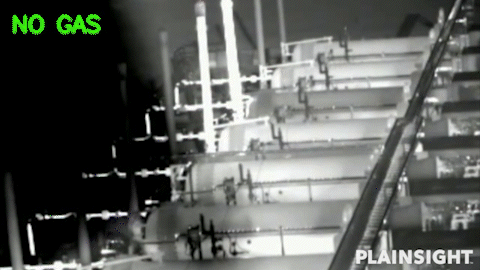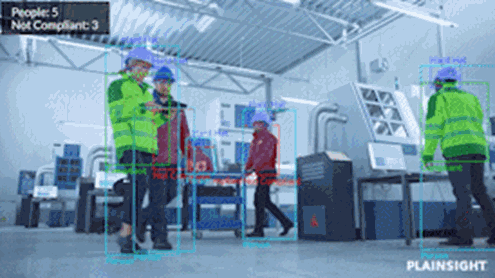Maintaining an unblinking focus on game-changing operational efficiencies across E&P spectrum
With Large Language Models (LLMs) and Generative AI flooding news headlines, the massive advancements in AI have become topics of everyday conversation. For the upstream sector, the time to implement practical applications of these exciting technological gains to drive digital transformation is here and now.
At the forefront of these transformative technologies, vision AI and 5G-accelerated Edge deployments are delivering real-time video analytics, enabling powerful solutions that give oil and gas operators a complete understanding of needs and risks across site and facility infrastructure, equipment, and workforces.
Positioned at the center of Gartner’s latest Emerging Tech and Trends Radar, Edge computer vision is enabling more proactive maintenance and monitoring with transformative solutions.
By integrating Plainsight’s “always-on” computer vision engine into their operations, E&P companies are equipping organizational decision-makers with a standardized, centralized source of real-time and predictive insights across the value chain. This streamlines operational processes and automates analyses for reporting that can scale across high-value use cases such as:
- Proactive identification and quantification of volatile organic compound (VOC) gas and liquid leaks
- Unblinking inspection and functional status of infrastructure and equipment
- Site-wide protection and enforcement of safety and security protocols.
From Leak Detection and Repair (LDAR) programs, to proper PPE usage and process compliance, to remote tank fill-level measurement, and detection of piping corrosion and predictive signs of equipment failures, technological advancements with cameras, 5G, Edge computing, and computer vision can reduce downtime and losses while mitigating environmental and health impacts.
The need for innovation has never been greater, and operators can now be empowered with solutions that transform their risk-producing traditional, manual processes and technologies and obtain the full value of their visual data in plain sight.
Below is a detailed look at computer vision’s capabilities for holistically transforming legacy processes across the upstream value chain, with an emphasis on remote monitoring to streamline operational management of VOC leak detection and tank fill-level monitoring.
INTO THIN AIR: VOC GAS LEAK DETECTION & QUANTIFICATION
The UN’s Global Methane Assessment identifies emission reduction—particularly during extraction, processing and distribution of fuel—as the crucial objective. Oil and gas operators are uniquely positioned to deliver on it and promote sustainability. LDAR is not merely the strategy with the greatest potential. It’s also the most affordable, with advancements in vision AI and Edge computing continually making it even more attainable and effective.
Reports on fugitive emissions identify a number of potential sources, underlining the necessity of a holistic approach to vision AI-powered monitoring: valves (60%), flanges and pumps (15%), relief valves (15%), and tanks (10%). Leak location is not the only variable presenting obstacles to timely remediation and accurate reporting. Grading the severity of leaks and prompting an appropriate response is another previously unattainable capability enabled by evolving Edge computer vision technology and connectivity advancements.
DATA CHALLENGE: SEEING THE INVISIBLE
Though operators are committed to locating and addressing excess emissions, traditional protocols have obvious drawbacks. Historically, locating the source of leaks and quantifying their severity has been time-consuming, manual work with limited scope. In addition to leaving open the possibility of human errors, traditional methods also potentially expose employees to unnecessary risks.
Toxic vapor analyzers (TVAs), colloquially known as sniffers, probe areas for detectable concentrations of VOCs. While capable of quickly determining leak concentrations, TVAs demand boots on the ground and are only useful for detecting gasses directly in their path. The Climate and Clean Air Coalition notes that, while relatively inexpensive in comparison to competing options, TVA tools need frequent recalibration. Even regulators may be lagging behind the latest developments. EPA Method 21, one of the organization’s recommended approaches to controlling fugitive emissions, suggests the use of handheld TVCs. Optical Gas Imaging (OGI) technology-equipped cameras can allow for broader monitoring at a safer distance.
The EPA’s New Source Performance Standards for Oil and Natural Gas (NSPS) include requirements that operators make use of the best available control technology (BACT) to track and report on their emissions. As requirements increase in parallel with sustainability and ESG goals, LDAR strategies will need accurate, reliable data input for compliance and reporting.
Even when organizations have the best technology at their disposal, they often deploy it via testing methods that still rely on manual, pre-scheduled inspections and reviews. While advancements may have reduced the total workload, they have not sufficiently reduced errors or time commitments. When relying on a still image, for example, imperfections in a photo can easily be misinterpreted as leaks. Legacy technology is also subject to the elements, such as extreme temperature and weather. Without vision AI models trained to ignore irrelevant distractions, the visual data that operators receive may not be useful. For an organization with a reactive approach to addressing such issues, the cost of false positives can add up fast in unnecessary truck rolls out to remote sites.
Existing leak detection methods that rely on human inspection are not just costly, risky, and unavoidably error-prone, but difficult to scale as well. To make the best-available technology as effective as possible, organizations need highly scalable solutions capable of conducting proactive monitoring, detecting and quantifying leaks, automating alerts, and enabling predictive maintenance across the full upstream value chain.
VISION AI SOLUTION
Plainsight’s end-to-end platform centralizes and standardizes visual data management and model-building to make LDAR processes part of robust downtime- and loss-prevention programs. They are the key to catalyzing digital transformation across the industry.
Real-time VOC gas leak detection & quantification. Plainsight’s automated VOC leak detection system (Fig. 1) for extraction pad deployment delivers detection and location of leaks (both on a map and in terms of camera and pad coordinates), grades leak severity (low, medium, high, or very high), and automatically sends an email or text alerts to designated individuals and systems within seconds.

Fig. 1. Real-time leak detection.
Constructing this solution involved augmenting the organization’s existing camera infrastructure (REO Link Optical cameras and FLIR OGI cameras) with high-accuracy computer vision models. Data was collected at the site in the form of 10-frames-per-second video from cameras. After a fully managed labeling and training process, the model produced dynamic polygonal detections of leaks on each relevant frame, as well as coordinates for locating leaks as outputs.
Arriving at these outputs and achieving the desired results was a five-part process:
- Stabilization to correct for camera shaking
- Color-channel frame stacking to simplify detecting leaks in motion
- Leveraging an instance segmentation model to generate detections and confidence scores
- Using a unique coordinate assignment system to match gas leak polygons on flat-plate and overhear images to provide precision
- Applying a moving average filter to ensure detections are only reported across
multiple frames to avoid false positives.
Remote tank fill-level monitoring. Historical fill-level monitoring processes for gas and water tanks are characterized by many of the same shortcomings as processes for leak detection. When traditional measurement instruments like depth sensors and waveguides malfunction or report inaccurate results (not an infrequent occurrence), workers have no choice but to climb on top of tanks, open the thief hatches, or even venture inside to rectify issues. These costly, risky legacy processes are others that computer vision-enabled monitoring can transform.
Deploying a vision AI solution for non-invasive tank fill-level monitoring (Fig. 2) may not even require an investment in new hardware. Plainsight has implemented such a solution with updates to an organization’s existing network of security cameras. Even a single thermal camera equipped with a vision AI solution can monitor a pad’s worth of tanks, reducing fugitive emissions without putting employees at risk. Without the need to open thief hatches, organizations reduce their overall carbon footprint as well.
![]()
Fig. 2. Remote oil & fluid tank level monitoring.
Capturing visual data at regular intervals, the solution then feeds video data to a proprietary regression model that effectively provides for x-ray vision, reporting on fluid levels, and delivering reports with location (pad and tank number) and fill-level detail.
Data logging was automated via integrations with existing SCADA systems. While these specific solutions streamed and stored data to the cloud, the addition of an on-site server could make the same technology applicable at the Edge, now possible with 5G to open the innovation floodgates.
MAKING THE BEST AVAILABLE TECHNOLOGY BETTER: COMPUTER VISION AT THE EDGE
As Gartner’s analysis attests, computer vision has broad near-term potential for businesses across sectors. So far, enterprises that have seen the greatest results from deploying computer vision to the cloud and Edge are characterized by both a reliance on legacy processes and an appetite for innovation. McKinsey’s report, Curbing methane emissions: How five industries can counter a major climate threat, suggests that oil & gas is one such industry, poised to deliver on abatement goals with the help of emerging solutions. The report reads, “the oil and gas industry is probably best-positioned to implement abatement measures, reflecting its relatively consolidated structure and deep resources.”
Historically, roadblocks to effective, real-time monitoring across extraction and production facilities have included both the sheer quantity of visual data collected each day (upstream producers generate an estimated 1.5 TB a day) as well as the latency and bandwidth concerns inherent to the industry’s remote locations. With the latest in camera developments, such as high-resolution thermal, infrared, and EPA OOOOA-certified cameras and thanks to Edge computing, the massive amounts of data collected at each point in the upstream supply chain can be analyzed in real time for safer, quicker, and more accurate insight generation to address and record incidents and other causes of unplanned downtime, for greater accuracy and easier reporting.
REDUCING DOWNTIME WITH EDGE VISION AI SOLUTIONS
Upstream companies experience 27 days of unplanned downtime annually. Altogether, these stoppages lead to nearly $40 million in costs. Vision AI solutions can both optimize the use of planned downtime and minimize equipment failures, injuries, and other causes of unscheduled stoppages, Fig. 3.

Fig. 3. Real-time safety & productivity.
Advancements in computer vision are enabling full scalability across sites, facilities and organizations to encompass the full scope of potential solutions, such as:
- PPE detection: Real-time monitoring for hats, vests, and other personal protective equipment keep workers safer and more productive
- Infrastructure & equipment monitoring: Vision AI-based monitoring proactive maintenance detects defects, such as corrosion and anomalies, before they lead to serious trouble
- Facility, site, & zone surveillance: Video data streams provide continuous input for perimeter protection, license plate recognition, sensitive zone monitoring, and threat detections
- Flare-ups, smoke & fire detection: Autonomously monitoring for smoke and fire prevents disaster and reduces exposure to regulatory fines.
SEEING THE FUTURE OF OIL & GAS As addressing climate change grows increasingly urgent, and organizations devote more resources to refining their LDAR protocols, computer vision’s potential for supporting transformative-yet-practical change will grow as well. Combining the best of quantifiable OGI solutions and expertly honed ML models, solutions for leak detection, tank fill-level monitoring, and more offer the speed, scalability and central source of insights necessary to predictively address issues that are not merely industry-critical but globally relevant.
The following best practices can help guide enterprises as they explore the nascent computer vision ecosystem:
- Take a solution-first approach: Computer vision succeeds when organizations fully understand the challenges they want to address and the goals they want to achieve, as well as the physical and technical environments in which the solutions will operate.
- Build trust with transparency, responsibility, and traceability as first principles: Versioning at every stage, open communication, and a clear definition of success helps enterprises avoid issues related to data bias and model accuracy, as their solutions evolve.
- Execute dynamically and plan for ongoing oversight and management: Deployment is just one stage in the computer vision lifecycle and sustained success requires an actionable strategy for ongoing monitoring, evolution, and continual improvement.
Designed holistically, deployed responsibly, and managed effectively, computer vision makes the technologies that have become just possible an everyday reality, helping enterprises quickly and sustainably solve new and long-standing challenges. For the industry, the future is now in plain sight with vision AI solutions for realizing game-changing efficiencies with digital transformations. WO

- Digital transformation/Late-life optimization: Harnessing data-driven strategies for late-life optimization (March 2024)
- The reserves replacement dilemma: Can intelligent digital technologies fill the supply gap? (March 2024)
- Digital tool kit enhances real-time decision-making to improve drilling efficiency and performance (February 2024)
- Digital transformation: Digital twins help to make the invisible, visible in Indonesia’s energy industry (January 2024)
- Digital transformation: A breakthrough year for digitalization in the offshore sector (January 2024)
- Quantum computing and subsurface prediction (January 2024)


